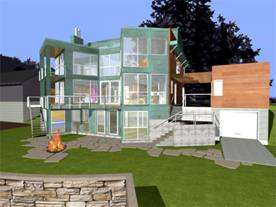Boston, February 7, 2008 – When Boston-based developer Duncan MacArthur hired architect Robert Augustine to design one of his many spec houses, little did he know that his family would love the completed building so much that he’d end up buying it himself.
Augustine’s «Cambridge House» in Cambridge, Mass., represents a new architectural movement in Boston to revitalize the area’s aging housing stock in non-traditional form. Since its completion this summer, the Cambridge House has garnered awards, raves and even pans for its contemporary challenge to the region’s colonial-style McMansions and townhouse neighborhoods. The Boston Globe said «With its flat roof, sharp angles and metal protuberances, the building strikes an aggressive, modernist profile that homeowners seem to either love or hate.» World Architecture News gave it its «House of Month» award for last month, calling the Cambridge House an «extraordinary space wrapped in sustainable materials like pre-patinated copper and red cedar that weather with grace.»
 Using Archicad, Augustine incorporated many sustainable design strategies into the project. Copper has the longest history of recycling of any building material known to civilization. About 80% of all copper remains in use today, with 40% of copper used annually recycled from prior uses. The living roof deck is covered in sod, and all floors and cabinet work is crafted from sustainable bamboo.
Using Archicad, Augustine incorporated many sustainable design strategies into the project. Copper has the longest history of recycling of any building material known to civilization. About 80% of all copper remains in use today, with 40% of copper used annually recycled from prior uses. The living roof deck is covered in sod, and all floors and cabinet work is crafted from sustainable bamboo.
The Archicad BIM model enabled Augustine to run animated sun studies to optimize the house’s solar efficiency. While high-efficiency glass windows capture the sun’s energy, two-sided (dark/light) roller shades reflect solar glare and mitigate overheating.
Beyond sustainability, Augustine said that working with BIM enabled him to collaborate better with building owners and contractors, as well as create designs that he otherwise couldn’t do using traditional 2D approaches.
«I’m an artist at heart, so the ability to create 3-dimensionally and experiment with different materials is the best design format for me,» he said. «And clients love it because the BIM model enables them to visualize the completed building and have me make changes in real time, rather than waiting days for me to redraw the blueprints. In fact, sometimes the only way I can get a client to buy into the design is to sit down with them and interactively reshape, resize and move things around with the Archicad BIM model so that they can see all the possibilities.»
 A solarium with opaque glass marks the entrance to the main living space. Stepping across the threshold, one is taken in by the expansive views, literally stepping into the outdoors through a sweep of floor-to-ceiling windows. Large glass panels with operable sidelights and sliding doors connect inside to outside at all levels. Decks and balconies extend the living space physically into this outdoor environment. The free flowing open floor plan provides flexible living space on four levels.
A solarium with opaque glass marks the entrance to the main living space. Stepping across the threshold, one is taken in by the expansive views, literally stepping into the outdoors through a sweep of floor-to-ceiling windows. Large glass panels with operable sidelights and sliding doors connect inside to outside at all levels. Decks and balconies extend the living space physically into this outdoor environment. The free flowing open floor plan provides flexible living space on four levels.
There are two main living levels – one off the street and a lower level leading to the grounds and lawn terrace. The terrace is paved with fieldstone inviting outdoor living and entertainment. The 3rd floor holds a library and study, along with the recreation room, called the Jungle Room (in a nod to Elvis), clad completely in weathered green copper. It opens to the sod covered roof deck, providing MacArthur and his family wonderful views of Cambridge’s Fresh Pond Reservation and Boston’s skyline.
Register for the free ‘Green’ BIM webinar!